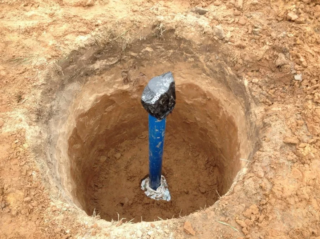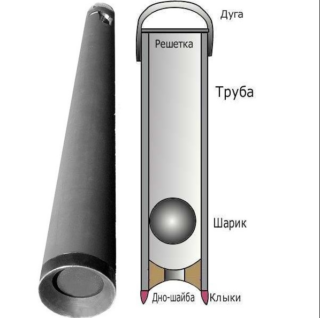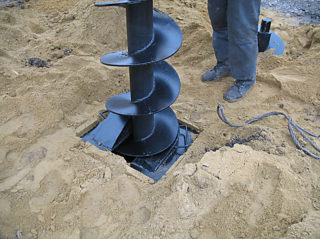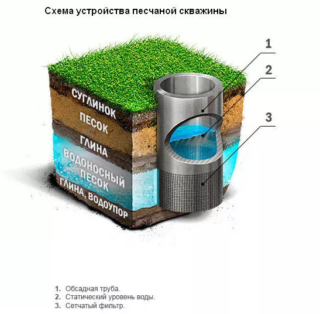Autonomous water supply of a suburban area is, first of all, a reliable source. One of these is a hole in the sand with your own hands. The productivity of such a hydrotechnical structure allows a family of three to be provided with water without interruption.
Well design and characteristics for sand
- Mine (aka casing). Made of steel or plastic pipes. Protects the walls of the drilled hole from sagging.
- Coarse filter. Located at the very bottom of the column near the aquifer.
- Submersible or surface pumping equipment.
- Pipes from the well to the house.
- Head and caisson. Protect the upper part of the source from debris, precipitation. In addition, a hydraulic accumulator is installed in the caisson, and automation for controlling the pump.
Sand Well Specifications:
- source depth - from 15 to 50 meters;
- productivity - 1-1.5 m3 / hour;
- casing pipe diameter - from 100 mm.
The section of the string is selected depending on the productivity of the well. The greater the fluid loss, the wider the diameter.
Advantages and disadvantages

When drilling sand wells, foremen distinguish the following advantages of sources:
- shallow depth of a hydraulic structure;
- the ability to form a well in 1-2 days;
- no need to use complex overall equipment (especially good for small suburban areas);
- lower cost of professional drilling;
- no need to obtain a license for a well (it is necessary for an artesian source).
Among the minuses are:
- instability of aquifer fluid loss;
- low well productivity;
- the risk of never reaching the sandy aquifer due to the geological features of the site;
- short service life (with constant continuous operation up to 8-10 years).
A sandy well is characterized by questionable water quality, especially if production facilities are located near the village. All atmospheric precipitation, wastewater, etc. fall into the upper aquifers.
Required equipment for drilling
To drill a deep sand hole instead of a thin Abyssinian well, you will have to prepare the following equipment:
- Metal screw with sharp edges. They will gently cut the soil as the source is shaping downward.
- Bayonet shovel.
- Garden cart for soil removal.
- Casing pipes with a cross section smaller than the auger.
- A pump with a hose for pumping the source.
- Winch and bailer.
Before performing work on the lowest part of the casing, holes should be made 2-3 mm in size with a step of about 5 cm. Such holes should extend approximately 50-70 cm from the lower edge of the tube. Then the outer part of the homemade filter is covered with a fine mesh. This will be a kind of coarse cleaning unit.
To start drilling on your own, you need to prepare the site. A layer of fertile soil is removed at the proposed location of the well to a depth of 1 m and dimensions of 1x1 m. This will further insure the well shaft against soil sagging during drilling.
Drilling process

The formation of a sandy source is carried out in one of the most convenient ways for the master - percussion-rope, auger or rotary using professional equipment.
Rope percussion drilling
A special drive-in glass (bailer) with a flap in the lower part is used. They work according to the following principle:
- A winch on a tripod is installed on the prepared site.
- A hammer glass with sharp lower edges is tied to it.
- Using a standard garden drill, make a primary hole in the ground.
- A thief is forcefully lowered into it from a height of 50-80 cm.Under its weight, it will cut into the ground. On impact, the flap of the glass opens to collect sand and soil. When the thief is lifted, the flap closes, preventing the contents from spilling out.
- With the help of a winch, the driven glass is lifted upward, freed from the soil.
Such actions are repeated, gradually deepening into the ground to a sandy aquifer.
Auger drilling

A screw is used to form the source. As a result, the excavation of soil and rocks occurs in a spiral. This drilling method is ideal for areas with soft, loose soil. It is better to rotate the auger with two or even three people. As it deepens, you need to grind the pipe of the base of the auger using threads or special couplings. To remove the device from the ground upon reaching the aquifer, an electric motor winch is used.
The source formation scheme involves the installation of a metal or polymer casing.
Professional drilling
Source generation by this method involves the use of professional equipment. Digging into the ground is fast. In parallel, the foremen immediately form the casing.
Which is better - a well for sand or an Abyssinian well
The sand well and the Abyssinian well have a number of their own characteristics. The Abyssinian well is good because it is drilled very quickly (only 3-5 meters deep), does not require large-scale work and complex equipment - everything is done with a small-sized pipe with a sharp end. Water can be supplied upstairs using a thin pipe with a cross section of 25-50 mm. This well is also called a needle. The arrangement can even be carried out in the basement of the house.
However, the Abyssinian well is a temporary solution. Water supply from this layer can stop at any time: seasonal subsidence of groundwater, wear, depletion of the vein. In addition, the higher the horizon is, the worse the quality of the water in it. In this regard, a sandy one-pipe well is many times better.
The cost of sand wells for water in the Moscow region starts at 1,000 rubles / running meter. The price increases depending on the parameters of the source, the material of the casing pipes used, the location of the site and the features of the relief.
Owner reviews
Judging by the owners' reviews of the deep sand well, such sources are popular.
Alexey, 35 years old. Two years ago, I ordered the drilling of a well from a special team. Made on sand to a depth of 45 m. Water gives in the range of 0.4-1 m3 / hour. We have enough for a family home with my wife. We water the garden from a pond nearby. The mineral composition of the water is normal. Slightly off-scale indicators of nitrates, but put a reverse osmosis filter. It's okay now.
Sasha, 45 years old. I inherited my well in the sand with a plot. Former owners say that its depth is 35 meters. Steel pipe casing. Slightly slipped sand in the water. I put in a good coarse filter. The well is already 5 years old. Water is supplied by 1.5 m3 / hour. Enough for a small house. I don't know how he will behave further. But so far, everything is fine. The water supply system operates from a station with a 25 liter hydroaccumulator.









